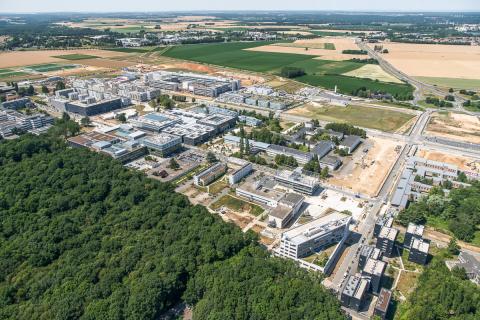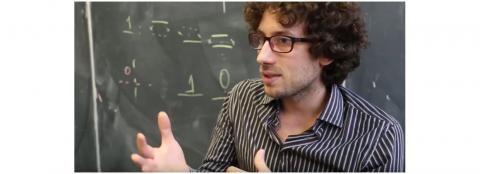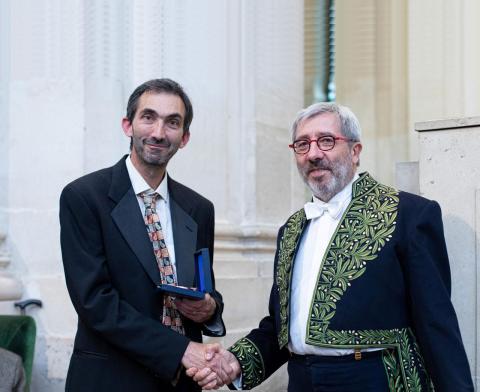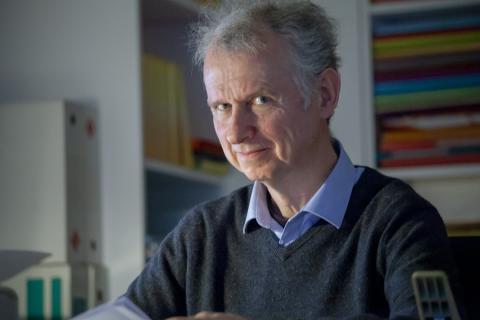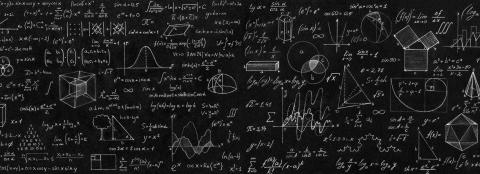
Maths at Paris-Saclay, on top: excellence and humanism at their best
France is placed first in the world for Mathematics in the Shangai 2020 ranking thanks to Université Paris-Saclay. Here are the key features of this collective and longed-awaited success.
Shanghai Jiao Tong University published its annual international ranking of universities by discipline (ARWU, Academic Ranking of World Universities) on 29 June 2020. Université Paris-Saclay, which this year entered for the first time under its own name, has deserved its status as an intensive research university of international standing by being ranked9th in physics (first in Europe) and in the Top 25 worldwide in medicine and agriculture. Moreover, it has been rankedtop for mathematics - which is a staggering result that deserves a closer look.
A French tradition
Behind this result there's a story to tell and an adventure to recount. It is the story of a discipline as deeply rooted in the culture of France as table tennis is in China. It is also the adventure of pioneers who had the vision to establish this discipline at the highest level in the world in the institutions which today are brought together under the umbrella of Université Paris-Saclay. The very nature of the disci-pline means that this story and this adventure could only take place because of the presence of out-standing scientific personalities who were able to establish excellence as a basic principle and, as a result, brought about a success which might seem inevitable, but which also had the touching fragility of human destiny.
As is often the case in science and in France, the story of mathematics is closely linked with history. One has to go all the way back to the Enlightenmentto see the birth of this tradition in mathematics, which values knowledge and reasoning as much as the ability to explain and apply.
France is a breeding ground for mathematical talent and the ‘école mathématique française’ regularly sees one of its members awarded the prestigious Fields Medal (as a reminder, the Fields medal is the highest honour awarded every four years to no more than four mathematicians under the age of forty). This most recent success is one for the French mathematical community as a whole. Not only is it once again recognised at the highest level in the world with this top position, but Sorbonne-University also enjoys third place and Paris-Sciences-Lettres has been ranked tenth.
This top ranking also tells the tale of the dual adventure of pioneering new campuses built south of Paris by the river in the 1960s at the time of the civil unrest of May 68, before history then repeated itself in 2010 with the construction of the vast Paris-Saclay scientific ‘cluster’.
"Excellence in mathematics is a national sport and two stars have shone especially brightly in Saclay since the end of the 50s. These are IHES and the mathematics department of Orsay"
A strong local presence since the 1950s
The end of the 1950s was a pivotal period in the history of the world and science. Léon Motchane, an industrialist of Russian origin, was passionate about mathematics. Determined to offer outstanding scientists a place where their research could flourish, he drew inspiration from theInstitute for Ad-vanced Study (IAS) in Princeton and createdIHES in 1958, which was to be dedicated to theoretical sci-ences (both mathematics and physics) and their interrelationships. 1958 was also the year René Thom won the Fields Medal and he joined IHES in 1963 at the same time as IHES moved to the Bures sur Yvette campus which we know today. It was also in 1958 that some of the teaching at the Paris Faculty of Science was transferred to Orsay, a vast campus, which had extended over several years out across the plateau and into the valley, now focused on new theoretical and experimental research in physics. It is interesting to note that IHES was long without a laboratory as such. It is only very recently that a unit has been set up linked with CNRS which is named after Alexandre Grothendieck, the prestigious mathematician who arrived at the IHES in 1958 and became the winner of the Fields Medal in 1966. Alexandre Grothendieck was a very influential figure in the world of algebraic geometry and had con-siderable influence on the intellectual development of young professors newly arrived at the Depart-ment of Mathematics at Orsay. This was the start of a long history of rivalry and scientific cross-fertilisation between these two top centres of mathematics, many of whose members later went on to be awarded a Fields Medal. Those awarded from IHES are Pierre Deligne in 1978, Alain Connes in 1982, Jean Bourgain in 1994 and Maxim Kontsevichin 1998. Those from Orsay are Jean-Christophe Yoccoz in 1994, Wendelin Werner in 2006 and Ngô Bao Chin in 2010. Laurent Lafforgue was awarded the prize in 2002. Having studied at Orsay, he had been recruited at the IHES only two years earlier.
[This first place awarded in 2020 is a reflection of our policy. We were able to set up a high-level, totally international culture of recruitment which is consistent with selection methods in France. ‘ Pierre Pansu, Professor at Université Pars-Saclay]
"This first place awarded in 2020 is a reflection of our policy. We were able to set up a high-level, totally international culture of recruitment which is consistent with selection methods in France."
A policy of openness and cooperation to promote excellence
IHES, as we have seen, was born out of the magnificently novel idea of patronage that was then care-fully cultivated and developed by narrowly focusing on recruiting, if not by financial means, only the best teachers of the highest international standard in a relatively unrestricted world. This has been this institution's endless, challenging task. In a university department such as the Mathematics Department at Orsay, recruiting the best professors according to high international standards is a challenge in terms of attractiveness and in terms of setting up procedures in the world of French academia, where the rules to be followed are as numerous as they are changing. However, this culture of openness to the international market, both in terms of finding a pool of brilliant candidates and in terms of recruiting, was used early on, notably under the leadership of John Coates. This ‘recruitment of expertise’ which he instigated has been maintained to this day and adapted over time, and remains in line with ever-changing legislation.
When we talk about attractiveness, we cannot overlook the decisive role that CNRS has played in mathematics by helping to establish the idea that, as is the case in most countries in the world, high-level research is mainly carried out in universities by academics. Many junior researchers in mathemat-ics at CNRS envisage their career development as being in the form of a professorship in a university mathematics department - and in a department of the same quality as the one at Orsay, if possible. Let us hope that in the context of the University of Paris-Saclay, this example of a broad-based vision be-tween institutions (organisations, universities and schools) will endure and spread. We also cannot ig-nore that the profession’s attractive working conditions are a major asset. From this point of view, the huge freedom of scope and choice of research areas, as well as the presence of a pool of master's and doctoral students of exceptional quality, have been very important strengths for the Department of Mathematics at Orsay since its beginnings.
It is worth remembering that the Orsay Mathematics Department has been ranked between 5th and 2nd in the Shanghai ranking over the years. Although Université Paris-Saclay now ranks first in mathe-matics, it is of course thanks to each of the nine mathematics laboratories which are brought together at Orsay and IHES, as already mentioned, as well as at ENS Paris-Saclay, Versailles, Evry, Centrale-Supelec, AgroParisTech, INRAE Jouy en Josas and CEA. Finally, it is also thanks to the resources invested by public authorities in the ‘Fondation Mathématique Jacques Hadamard’ (FMJH) that the message of cohesion, which is essential to the success of this ambitious project, has been particularly powerful and effective in mathematics and enabled the establishment of a master's degree and a doctoral school on a scale which makes them known across the world.
"Of course, it is the very existence of Université Paris-Saclay which has allowed the pooling of all these strengths. Its own existence is due to the courage and tenacity of Sylvie Retailleau, a woman who saved it when it appeared to have been lost and who today is its President"
A top ranking which needs to be protected
Mathematics requires, first and foremost, human investment. There is no large equipment needed which is difficult financially for a university in France to purchase and no laboratories with complicated and controlled experimental conditions. Instead, it is the working conditions which are fundamental for the achievement of the expected alchemy between brains, interactions, ideas and the appetite of bud-ding mathematicians to learn. Mathematics at Université Paris-Saclay, like mathematics departments throughout France, is facing up to its own future in order to defend and maintain its status as a great centre for research and training in mathematics. This requires continued investment in the training of young researchers, ensuring freedom for research and thinking as well as enhancing the value of the doctorate and attracting brains very well-versed in mathematics into companies to solve problems which are not only linked to mathematics but also to all the complex issues that every company has to solve on a daily basis.
This challenge will also involve the development of mathematics in connection with artificial intelli-gence. This concerns increasingly varied branches of mathematics (statistics, optimisation, optimal transport, geometry etc.), but we must not restrict ourselves to these examples and to this field of ap-plication. A mathematical concept considered useless one day may find a crucial application the next - this unpredictability must also be taken into account. Scientific history is littered with examples that call for caution and restraint in making judgements in this area and encourages us to believe in basic sci-ence again and again. Today the adventure continues at Paris-Saclay with the Graduate School of Mathematics and FMJH defending the values which forged today's success over the years. Those values are excellence, openness, humanism and cooperation. Our continued success will rely on our ability to reconcile ‘scientific attractiveness’ with ‘pedagogical adaptability’ so that the best students and the best scientists are willing to come and work in one of the centres of teaching and research in mathe-matics at this wonderful university. As our grandchildren will say - you don't need to have studied at Paris-Saclay to understand that you just have to keep working!
A lire aussi
Portraits de chercheurs
Jean-François Le Gall – a strange sort of menu for a mathematician
A member of the French Academy of Sciences, mathematician Jean-François Le Gall is a specialist in the theory of probability...
Mathematics in l'Edition, the scientific journal of the Université Paris-Saclay
l'Edition 8
In the issue
Teaching, learning: Institute Villebon - Georges Charpak, innovative practical teaching methods and developer of talents
Science Outreach: Hard times for climate sceptics
Research: When urban mobility pursues a chosen path
Research: When the infinitely small allows you to see full size
Business & Innovation: Artificial intelligence
Research: From data to decision: applications and implications
Research: Gene therapies: A new way forward
Campus life: Beginning of new building work for the Biology-Pharmacy-Chemistry division
...
Read this issue
l'Edition 12
In the issue
Teaching, learning: International summer schools look to the future
Science Outreach: The wind of aeronautics sweeps through high schools
Research: It’s now or never for ailing Earth
Research: Revealing the secrets of ancient and heritage materials
Business & Innovation: The Study of Life Sciences at Université Paris-Saclay
Research: Algorithms and the human brain
Research: Charging tomorrow’s electrochemical cell
Campus life: Lights, camera, action!
...

